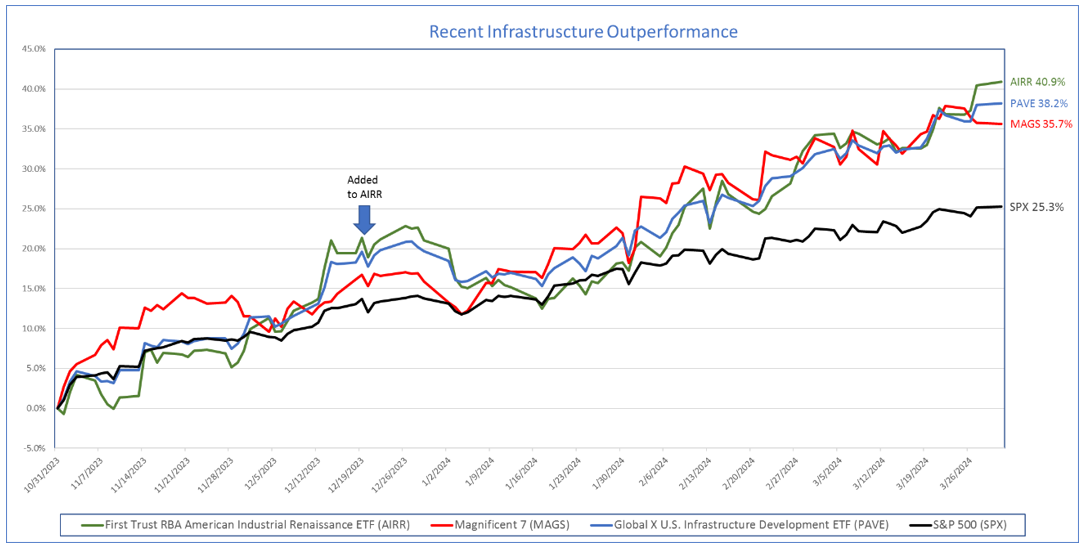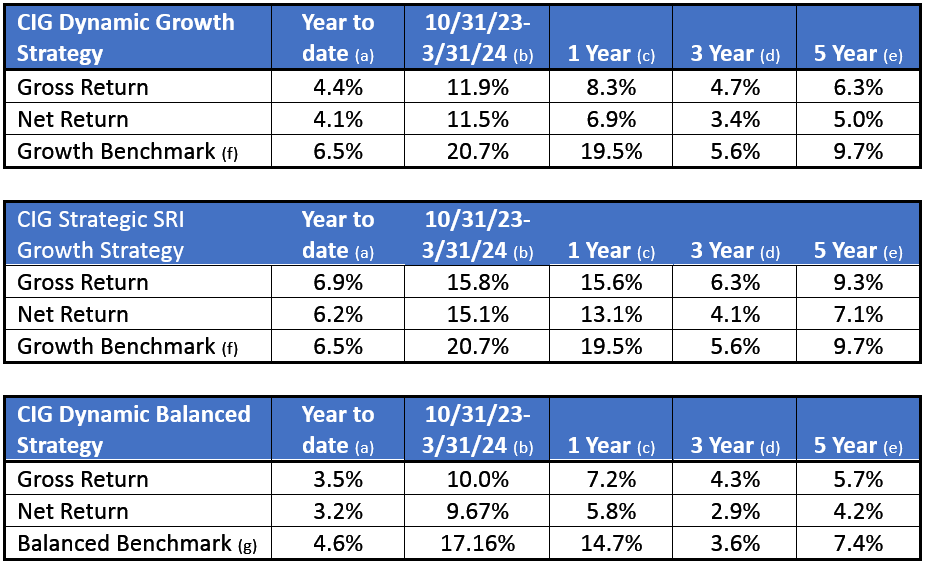
CIG Asset Management Update: Infrastructure, Gold, and Strategic Positioning in a Changing Landscape
In our October 2023 CIG Asset Management Update: Year-to-Date U.S. Stock Performance in Pictures, we discussed our theme of Clean Transition Investing as a possible alternative way to participate in the stock market without chasing the Magnificent 7 stocks. [i] This theme focuses on the 2015 Paris Agreement, which outlined the long-term goal of reaching net zero emissions by the year 2050. However, global spending fell short in 2023, reaching an estimated $1.8 trillion out of the necessary $5 trillion annually. [ii]
We initially bought First Trust RBA American Industrial Renaissance ETF (AIRR) to participate in Clean Transition Investing for our CIG Dynamic Growth Strategy and CIG Dynamic Balanced Strategy in September 2023. We then added more AIRR in December 2023. Most recently, we added an additional investment in the Global X U.S. Infrastructure Development ETF (PAVE). How are these investments doing?
As seen in the chart below these infrastructure investments, (AIRR) and (PAVE) outperformed the Magnificent 7 stocks (MAGS) and the S&P 500 (SPX) for the period October 31, 2023, through March 31, 2024.[iii]

Data from Barchart.com for the period 10/31/2023 to 3/31/2024
Past performance is not indicative of and not a guarantee of future results, but we are encouraged that it it may be possible to enjoy positive market outperformance without chasing the Magnificent 7 stocks which, in our opinion, are in a bubble.
Moving on to another asset class, as of April 19, 2024, Gold futures closed at an all-time high of $2,398.40 / ounce on the COMEX exchange. [iv]As illustrated in the chart below, for the period March 31, 2019, to April 12, 2024 – just over five years – Gold, (symbol GCY00) has captured 100% of the S&P 500’s return! [v]

Data from Barchart.com for the period 3/31/2019 to 4/12/2024
Perhaps more impressively, from the peak of the dot-com boom in March 2000 through April 10, 2024, The S&P 500 has gained +244%, but Gold gained +738% – triple the return! [vi] Gold and miners continue to be a part of many of our client’s managed portfolios.
Why has Gold enjoyed such a stellar performance?
According to the latest budget update from the Congressional Budget Office (CBO), the U.S. government ran a staggering budget deficit of $1.7 trillion in fiscal year 2023. This deficit represents 6.3% of the country’s gross domestic product (GDP), significantly surpassing the 3.7% average observed over the past 50 years. Notably, excluding the Great Financial Crisis and the COVID-19 pandemic, this deficit-to-GDP ratio is the highest since World War II. [vii]
In 2023, the government’s net interest costs reached a staggering $659 billion, marking an 87% increase compared to the amount in 2021. [viii] The CBO’s latest projections also raise concerns: total U.S. federal government debt is projected to climb from 97% of GDP last year to 116% by 2034—surpassing the debt levels seen during World War II. Bloomberg Economics conducted extensive simulations to assess the fragility of the debt outlook. Alarmingly, in 88% of these simulations, the results indicate that the debt-to-GDP ratio is on an unsustainable trajectory, signifying an increase over the next decade.[ix] These unwieldly debt obligations and large budget deficits could potentially weaken the U.S. dollar relative to other currencies.
The weaponization of the U.S. dollar became evident following Russia’s invasion of Ukraine, leading to unprecedented financial repercussions for Putin’s regime. World leaders are now actively reducing their reliance on the U.S. dollar.[x]
On April 8, 2024, U.S. Treasury Secretary Janet Yellen issued a stern warning in Beijing: “Banks facilitating significant transactions related to Russia’s defense industry risk U.S. sanctions.”[xi] Russia’s Foreign Minister Sergey Lavrov met in Beijing to counter mounting pressure from the U.S. and its allies.[xii] Simultaneously, central banks worldwide are diversifying away from U.S. dollar reserves. They’ve been accumulating gold reserves at an astonishing pace—over a thousand tons in 2022 and 2023.[xiii] As other countries grow wary of holding U.S. assets due to potential reprisals, gold emerges as an increasingly attractive investment. The question remains: How will the United States manage its debt if global confidence in dollar-based assets wanes? Of note, as the dollar weakens, investments outside of the U.S. become more attractive to investors. At CIG, we are keenly focused on exploring international investment opportunities to capitalize on this trend.
America’s debt-to-GDP ratio is regaining the heights last seen post WWII. Past periods of sacrifice tended to be followed by burden-sharing and higher taxes. In 1932, as the Great Depression raged, America’s top marginal tax rate rose to 63% and continued higher through 1944 when it hit 94% on incomes over $200,000 (equivalent to $2.9mm in today’s dollars). The post-war economy boomed as America rebuilt the world. The top marginal rate remained above 90% until 1964 when we lowered it to 70%. [xiv] But today, we’re unsure whether we’ll make similar choices to raise taxes and share the burden. Nor do we know the societal consequences that come from refusing to equitably share our burdens.
In light of current conditions, our investment strategy remains nimble. We are encouraged by the recent performance of our new infrastructure investments. Equally noteworthy is our commitment to gold as a long-term asset, which has yielded productive results. The recent surge in gold prices, reaching an all-time high, underscores its resilience and attractiveness over the past five years-mirroring its performance since the Dot Com bust.
As we navigate the financial landscape, we maintain a cautious optimism, leveraging our insights and strategic positioning to potentially capitalize on opportunities while attempting to prudently manage risks. Our commitment to making prudent investment choices continues to drive results for out clients.
Strategy Returns as of 3/31/2024:

Performance has been attested to by ACA Group for the period August 1, 2018, through December 31, 2022.
Strategy returns are calculated independently on a daily basis and linked geometrically to produce a monthly return. Total investment performance includes realized and unrealized gains and losses, dividends, and interest. Accrual accounting is used to record interest income while dividends are recorded on a cash basis. Trade date accounting is used for calculation and valuation purposes.
Past performance is not indicative of future results.
(a) Represents performance from January 1, 2024, through March 31, 2024.
(b) Represents performance from October 31, 2023, through March 31, 2024.
(c) Represents performance from April 1, 2023, through March 31, 2024.
(d) Represents annualized performance from April 1, 2021, through March 31, 2024.
(e) Represents annualized performance from April 1, 2019, through March 31, 2024.
(f) The Growth Benchmark is a blend of 60% Russell 3000, 25% MSCI All-Country World ex US and 15% Bloomberg US Aggregate Bond indices.
(g) The Balanced Benchmark is a blend of 45% Russell 3000, 10% MSCI All-Country World ex US and 45% Bloomberg US Aggregate Bond indices.
[i] The ”Magnificent 7” stocks are Apple (AAPL), Microsoft (MSFT), Nvidia (NVDA), Alphabet (GOOG), Meta Platforms (META), Amazon (AMZN) and Tesla (TSLA). https://www.nasdaq.com/articles/the-easiest-way-to-remember-the-magnificent-7-stocks-and-why-you-should-care
[ii] GlobalX – Why Should You Consider Investing in U.S. Infrastructure Development?
[iii] Calculated by CIG Asset Management for using data from Barchart.com for the period 10/31/2023 to 3/31/2024
[iv] Data from finance.yahoo.com
[v] Calculated by CIG Asset Management for using data from Barchart.com for the period 3/31/2019 to 4/12/2024
[vi] Calculated by CIG Asset Management for using data from Barchart.com for the period 3/31/2000 to 4/12/2024
[vii] Data from https://www.cbo.gov/publication/60053 https://fred.stlouisfed.org/series/FYFSDFYGDP
[viii] Data from https://www.cbo.gov/publication/60053 https://fred.stlouisfed.org/series/FYFSDFYGDP
[ix] https://www.fastbull.com/news-detail/a-million-simulations-one-verdict-for-us-economy-3825714_0
[x] https://www.bloomberg.com/news/articles/2023-06-02/putin-s-war-ignites-backlash-against-dollar-across-the-world
[xi] https://www.bloomberg.com/news/articles/2024-04-08/yellen-threatens-sanctions-for-china-banks-that-aid-russia-s-war
[xii] https://www.nytimes.com/2024/04/09/world/asia/xi-lavrov-russia-china.html
[xiii] The High-Tech Strategist April 2, 2024
[xiv] Data from https://taxfoundation.org/data/all/federal/historical-income-tax-rates-brackets/

CIG Press Release: CIG Capital Advisors Announces New Advisory Board as They Posture for Growth in 2024
Contact: Joan Frank
Tel: (248) 330-0001
Email: joan@bfrankcommunications.com
www.bfrankcommunications.com
FOR IMMEDIATE RELEASE:
November 29, 2023 — Southfield, MI —CIG Capital Advisors is gearing up for major strategic growth in the upcoming years, starting with the introduction of its new CIG Advisory Board, which will play a pivotal role in advising and shaping the company’s strategic direction and future growth.
A leading independent wealth management and business advisory services firm, CIG has recruited a distinguished group of thought leaders and innovators to serve on this board, including experts in health care, financial services, investment, and international management to enrich and elevate services for the firm’s expanding client base.
The Advisory Board members include:
- Dr. Mark Kelley, MD – Chair – Former chief executive officer, Henry Ford Medical Group and senior lecturer at Harvard Medical School
- Osman Minkara – Founder and chief executive officer at CIG Capital Advisors
- Jeff Davidson – Former head of investment at Taubman Family Office and senior consultant
- Nigel Thompson – Former president and chief executive officer, Yazaki North America
- Dina Richard – Senior vice president, treasurer and chief investment officer at Trinity Health
- Dr. Raza M. Khan, MD, FACS – Senior partner at Uropartners
- Mindy Richards – Embedded health care consultant and CEO of ChangeScape, Inc.
- Dr. Samer Y. Kazziha, MD, FACC – Senior and head of Cardiovascular Consultants P.C.
The expertise of the Advisory Board will be invaluable in growing CIG’s specialized wealth management and business advisory solutions for successful entrepreneurs and senior executives. The Advisory Board will enhance CIG’s ability to deliver strategic thinking and innovative approaches to a broad range of clients looking to grow their professional or personal wealth opportunities.
“We are honored to welcome these accomplished individuals to our Advisory Board,” said Osman Minkara, founder and CEO of CIG Capital Advisors. “Their guidance and insights will be invaluable as we continue to innovate, grow, and adapt to the ever-changing wealth management and business advisory landscape. We believe that their collective wisdom will help us steer CIG toward new horizons.”
That dedication to excellence is embraced by the Advisory Board, underscoring CIG’s determination to further expand its leadership in the financial industry. “As advisory board members, our mission is to drive innovation and bring about positive change through collective expertise and collaboration,” says Dr. Mark Kelley. “We aim to stay ahead of the curve by anticipating trends and proactively addressing challenges.”
CIG Capital Advisors has built robust integrated services that elevate the client experience. Serving as their clients’ trusted partner, CIG is committed to providing unique solutions to complex problems and to guiding clients on their individualized financial journeys. That forward thinking will drive the firm’s growth in the years ahead, as they offer robust guidance and expertise with the same personalized attention that sets CIG apart from the crowd.
About CIG Capital Advisors
Founded in 1997, CIG Capital Advisors (CIG) is a wealth management and business advisory services firm serving high-net-worth clients—enabling these individuals and families to focus on what is most important to them. CIG tailors its delivery of service based on the situation, goals, and aspirations of each client it works with. The firm seeks to provide exceptional client benefit through its independent, objective, and transparent strategic thinking and implementations. CIG is based in Southfield, MI.
For more information on CIG Capital Advisors visit cigcapitaladvisors.com. Media inquiries contact Joan Frank at B. Frank Communications at (248) 330-0001 or joan@bfrankcommunications.com.
Advisory Board
Image: Conny Schneider/Unsplash

Find Your Optimal Staffing Level
If your practice has too few staff members, patient care may suffer and collections may slow down. If you have too many, you’ll face rising operational costs. Is there an optimal level that will allow you to operate your practice efficiently without letting your costs get out of control and creating dissatisfaction among patients?
Start by using medical industry benchmarks for comparison. Various organizations collect a wide variety of data on staffing levels. You’ll want to compare apples to apples, so it’s important that you use data from practices similar to yours in terms of practice area(s), size, annual revenues, and the number of physicians employed. It’s also important to follow the same methods used in the survey when determining your practice’s numbers for comparison.
Look at These Key Benchmarks
Two benchmarks you should look at are the average number of support staff per full-time-equivalent (FTE) physician and the percentage of gross practice revenue used for support staff salaries. The first benchmark is the number of full-time staff (not including mid-level providers) required to support one full-time physician. The percentage of gross revenue is total staff salary expense divided by gross revenue over the same period.
Be Ready To Adjust
If your physicians see more or fewer patients daily than the average patient load, you’ll likely want to compensate for that difference when you compare your practice with benchmarks. Looking at the number of patient visits per year or week or the gross charges per physician can help you gauge your support staff to FTE physician ratio. Similarly, your practice may require more support staff than a benchmark indicates if your ratio of mid-level providers to physicians is higher than a benchmark survey suggests. By the same token, your need for support staff may be lower if you have no mid-level providers.
Start by using medical industry benchmarks for comparison.
We Can Help
To schedule a complimentary consultation with a CIG Capital Advisors professional, click here.
Article Links:
https://www.medicaleconomics.com/view/making-medicine-better-for-women
https://insidexpress.com/lifestyle/health/the-only-guide-that-make-hiring-for-your-private-medical-practice-easy/
https://www.ama-assn.org/practice-management/private-practices/tips-help-private-practices-lessen-sting-staffing-shortages
images: iStock by Getty Images

Practice Resolutions for the New Year
The end of the year is a time for reflection. It’s also a chance to apply the lessons of the past going forward. If one of your 2022 goals is to improve the operational, administrative, and financial aspects of your medical practice, here are some ideas you might be able to incorporate in your list of New Year’s resolutions.
Review Current Patient Service Approaches
The delivery of superior patient service takes leadership and commitment to patient needs. You can resolve to use staff meetings and personal example in the coming year to reinforce your practice’s values concerning patient treatment and care.
Superior care translates into high rates of patient satisfaction. Patient surveys have been found to be a particularly effective tool in providing feedback regarding a wide range of patient care and customer service issues.
Monitor Financial Performance Regularly
Tracking your practice’s financial results during the year allows you to identify trends and make changes as needed.
You may want to put a dedicated staff member in charge of focusing on several key indicators or metrics, such as your practice’s collection rate, overhead percentage, and number of office visits. These indicators should be reviewed at regular intervals as the year progresses.
We can help you interpret what the numbers are saying and see the big picture. Staying on top of performance throughout the year can enhance your practice’s financial management.
Improve Collections and Billing
Finding a way to streamline and simplify payment for services rendered may be a goal for your practice in the coming year. One approach that can work to reduce both billing expenses and collection difficulties: Have your receptionist ask for copays before your patients leave your office – or even better, when they arrive.
Ensuring that you bill for all of your hospital services in the coming year is another worthwhile resolution. When you are seeing patients at a hospital, be sure to make a record of your work promptly and transmit the information to your billing staff. Though it’s more efficient to call your billing office immediately after you complete procedures, if that’s not feasible, create electronic or written notes for later use by your billing staff.
Establish a process for following up on unpaid accounts. Make follow-up calls within a certain number of days of when services were provided or when the original bill was due.
Establish a Training Plan
Staff training can pay off in increased productivity, improved morale, and a more efficient operation. Look into what ways your support and administrative staff could benefit from training, seminars, and other educational opportunities. Budget for a specific dollar amount to be spent on staff development each year. Online seminars and training sessions can be a cost-effective alternative.
Plan for Capital Expenditures
As you prepare your budget, identify the equipment you intend to replace and set priorities for the systems and technologies your practice will need going forward. Determine what, if any, areas in your current facility need to be remodeled or expanded.
Preparing a detailed plan with a very specific timetable for achieving goals can help you clarify what needs to be done to keep your practice competitive.
We can help identify and prioritize the measures that will help your practice run more efficiently in the coming year. Please contact us for assistance.
Finding a way to streamline and simplify payment for services rendered may be a goal for your practice in the coming year.
To schedule a complimentary consultation with a CIG Capital Advisors professional, click here.images: iStock by Getty Images

Easing into Retirement
Given the physical and emotional demands of their profession, it’s little wonder that some physicians look forward to retirement. However, many other doctors nearing retirement age are reluctant to turn their backs completely on their profession and would rather find a way to ease into retirement.
What should you do if retirement is on the horizon, but you would prefer to transition gradually into retirement by working part-time? Here are some things to consider if you are thinking of cutting back on your work hours.
Review Your Finances
First off, determine if you can afford the reduction in earnings that reducing your work hours will entail. Pay particular attention to any debt you are carrying (mortgages, etc.). Ideally, you don’t want to be overly burdened with debt once you are no longer practicing full-time.
A review of your current net worth can give you a clearer picture of your overall financial standing. Net worth takes into account the value of all your assets as well as your outstanding liabilities.
If you’ve been funding a tax-favored retirement plan, hopefully you have accumulated sufficient assets to provide a steady stream of income for all the years you may be retired. If you still haven’t met your goal, you’ll want to determine if your earnings from part-time work will allow you to comfortably continue adding contributions to your retirement plan. You’ll also want to determine when you can start taking penalty-free withdrawals from your plan(s) and project what your tax situation will look like. These are all issues we can help you assess.
Look at Your Options
If you are part of a multi-physician practice, talk to your colleagues about what arrangements can be made for you to start cutting back your hours. You may need to revise your practice agreement to incorporate a new compensation arrangement. Typically, such arrangements are based on the productivity of the part-time physician less a share of practice overhead expenses.
If you are a solo practitioner, you may find it hard to practice part-time without creating problems with your current patient base. Patients may feel that you can’t deliver the type of patient care they expect if you are practicing part-time. Bringing in a physician assistant may be helpful. However, recruiting another physician who would eventually take over the practice may be the most effective route for solo practitioners.
Give careful consideration to the financial arrangements you make with the new physician. When it comes time to sell, you’ll want to have a formal purchase agreement that outlines all of the rights, obligations, and responsibilities of the buyer(s) and the seller. It should also include a valuation of the practice.
Consider Malpractice Insurance
Don’t ignore the issue of malpractice insurance when you are weighing the pros and cons of going part-time. You need to be certain you will be covered during your part-time years and after you stop practicing completely. “Tail coverage” can protect you against any malpractice claims that may be filed against you after you retire.
We Can Help with Retirement Planning
Whether you are serious about transitioning to part-time work or are simply exploring your options, be sure to consult with us. We can help you run the numbers and evaluate your financial preparedness for retirement.
If you are part of a multi-physician practice, talk to your colleagues about what arrangements can be made for you to start cutting back your hours.
To schedule a complimentary consultation with a CIG Capital Advisors professional, click here.
images: iStock by Getty Images

Exiting Your Practice? Important Issues to Consider
Providers exit their practices for a variety of reasons — dissatisfaction with the demands of running a business, the desire for a less strenuous work schedule, frustration with insurers, retirement. If you are thinking about exiting your practice, there are several steps you should take now that will help you maximize the purchase price and ensure a relatively smooth transaction.
Lay the Groundwork
Start by taking a critical look at your practice’s current financial condition. Identify areas of weakness. For example, does your practice experience poor collections or weak cash flow? How do your staffing levels compare to those of similar practices? Issues such as these can reduce the appeal of your practice. It’s to your benefit to deal with them well before you put your practice on the market.
You’ll want to have a realistic appraisal of your practice’s potential worth before you put it up for sale. Tangible assets, such as health care equipment, computers, and furniture, are relatively easy to value, though they generally make up only a small part of a health care practice’s total value. Goodwill is an intangible asset that can be difficult to value. But there are methods that can be used to establish a reasonable estimate. Some other widely used methods include the discounted cash flows and market multiples methods.
Identify Potential Buyers
You may receive an unsolicited offer. If you don’t, consider reaching out locally or contacting a broker who specializes in exiting health care practices. An experienced broker can identify and contact qualified potential buyers.
The speed with which a sale may occur will largely depend on the deal you’re seeking. Do you want a buy-out that will let you continue to practice as an employee? In that case, looking for a group practice, hospital, or other corporate buyer may be the best route. If the sale goes through to one of these entities, you will be able to continue to work in health care without the responsibilities of ownership.
If retirement is your goal, you may opt for a gradual buy-in by a provider who will take over your practice. Typically, this arrangement requires you to employ the prospective buyer and, under the terms of the deal, after a trial period of a year or two, offer a partnership with a documented exit arrangement for you. This arrangement could be in the form of a severance package.
Review All Offers Carefully
If you receive an offer, your focus should be on the would-be buyer’s financial condition and the payment terms if you plan on retiring. If you plan to continue working at the practice with the individual or entity who may buy it, you should carefully review all ramifications, including transfer expenses and malpractice terms involved in the sale.
Apart from satisfying yourself about the financial and legal issues involved in the sale, you should also feel that you will be able to fit into the potential buyer’s organization and that your advice and input will be welcomed.
Remember, whatever way your practice’s sale is structured, there will be tax implications. Let us help you secure the most tax-advantageous sale terms. Please contact us if you would like assistance.
The speed with which a sale may occur will largely depend on the deal you’re seeking.
We Can Help
To schedule a complimentary consultation with a CIG Capital Advisors professional, click here.
Dental tools photo: Succo/Pixabay
Stethoscope photo: Julio César Velásquez Mejía/Pixabay

Maximize Revenues and Trim Expenses by Streamlining Practice Operations
Improving operational efficiencies should be an ongoing process for all medical practices. Reevaluating and examining existing procedures can help identify areas of weakness that can drain revenues and increase costs, lowering the bottom line. The following suggestions may help jump-start your own thoughts about ways you can maximize your practice’s revenue stream and reduce costs without sacrificing patient care.
Keep Coding Current
Miscoding is expensive: It can reduce reimbursements and cause delays or denied claims. Miscodes are often due to old data, under coding to avoid penalty risk, or leaving coding decisions to inexperienced support staff.
For more accurate coding, maintain updated coding manuals and software, keep a code reference summary handy in exam rooms, and use online coding resources. If you make notes during each patient visit, you’ll be able to bill more accurately. Taking coding refresher courses will help your staff stay current with coding practices.
Finally, periodic assessments of your practice’s coding accuracy can help uncover problem areas. These assessments could include a review of your practice’s forms and a comparison of billing codes with the actual services that were provided.
Improve Employee Productivity
Consider these ideas for improving productivity:
-
-
- Set productivity goals and offer incentives to your staff for reaching those goals
- Delegate administrative functions (ensure that physicians spend most of their day doing only what physicians can do)
- Plan patient flow so that physician and medical assistant billable time is maximized
-
Exercise More Efficient Control over Staff Time
It is often possible to trim overtime expenses without reducing the quality of patient care. Start by reviewing the payroll records of your non-exempt employees to determine who worked overtime and why. Find out if your practice was fully staffed and simply busy or if it was short one or more employees on the days when the overtime occurred. If overtime was necessary because you were short-staffed, see if this was due to vacations or some other controllable situation. It may be time to revise your practice’s policy on vacation time if scheduled time off was the cause of the jump in overtime.
Update Fee Schedules
Patients can be price conscious and resistant to fee increases. Nevertheless, if your practice hasn’t raised fees in some time, you may want to consider appropriate increases. In addition, you should periodically examine the reimbursement rates of all the plans you participate with and reevaluate whether it makes economic sense to continue accepting patients from some of the ones that reimburse poorly.
Improve Your Purchasing Practices
Medical and office supplies can be a significant part of a practice’s expenses. Busy practices may take the path of least resistance and continue ordering from the vendors that have always supplied them. That can be an expensive mistake. Choose several of your practice’s “high-volume” items and find out how much other vendors are charging. Use that information to negotiate lower prices with your current suppliers, consolidate orders with fewer vendors, or switch to new suppliers to save money.
We Can Help
We can help you identify areas where streamlining operations may help optimize your practice’s bottom line. Please call.
. . . if your practice hasn’t raised fees in some time, you may want to consider appropriate increases.
To schedule a complimentary consultation with a CIG Capital Advisors professional, click here.
Photo: Daniel Sone/Unsplash

Measure Your Medical Practice’s Performance
Is your medical practice moving forward, standing still, or losing ground? You’ll know the answer if you compare different aspects of your practice’s operations to appropriate benchmarks (as you can do here using the CIG Capital Advisors Medical Practice Dashboard). Benchmarking can give you the data you need to make informed management decisions about the direction of your practice.
What To Measure
There are two types of benchmarking: Performance and process. Performance benchmarking compares a practice’s operating performance internally over time and externally against other practices of a similar size in the same specialty. Process benchmarking compares a practice’s work protocols. By tracking key benchmarks from quarter-to-quarter or year-to-year, you can identify the areas in which progress is being made.
Start by choosing a few indicators that are important to you. For each indicator, determine your objective and define what you’ll measure and how you’ll do it. Keep tracking the data regularly so that you can make meaningful comparisons over time. Here are some of the indicators your practice may want to use in its analysis.
Profitability/Cost Management
Look at measures such as net income (or loss) per full-time equivalent physician and operating cost per physician. Other useful areas to analyze would include operating costs as a percentage of total medical revenue and total support staff cost per physician.
Billings and Collections
What percentage of submitted claims is rejected by third-party payers? Is that percentage higher or lower than it has been in the past? If you determine that the number is increasing, you’ll need to review the quality of your coding. If coding errors are at fault, it’s critical that you tackle this issue immediately.
Examine the percentage of accounts receivable over 120 days. Is it higher or lower than what has been your experience? What about your practice’s fee for service collection percentage or the dollar amount of bad debts per physician? These are measures that you can evaluate.
If you track your copay collection rate for several quarters and see that it is deteriorating, have your front desk staff pull up each patients’ records when making appointments and remind them about past due payments. In addition, remind your front desk employees to ask for copays at the time of service and to request any outstanding amounts.
Patient No-shows
If your measurement of patient no- shows reveals an uptick in the numbers, consider having your staff make reminder calls or charging for missed appointments.
Time Patient Spends in Office
Patients resent lengthy waiting times. You can track the average time patients spend waiting to see a physician or physician’s assistant. Start by giving a percentage of patients (10%, for example) a card that your receptionist time stamps on arrival and collects and stamps again on departure. If the data reveal an increase in wait times, overbooking may be an issue. If that’s the case, you’ll want to reexamine your procedures and time blocking. You may even have to look into adding another physician, physician’s assistant, or nurse practitioner.
There are other indicators your practice can use to evaluate how well it is doing. Keep tracking the data regularly so that you can make meaningful comparisons over time, and be sure to try our Medical Practice Dashboard to see how your medical practice compares to other peer practices nationally. For a confidential consultation with a CIG Capital Advisors medical practice advisor, email Brian Lasher.

CIG in the News: MedCityNews, “Why now is a good time to consider exit strategies for your practice”
The coronavirus pandemic has been a catalyst, both supercharging the investment demand for physician practices and accelerating the consolidation trend in the healthcare industry. With strong sale prices on an upward trend, CIG Capital Advisors discusses in MedCity News what physician-owned practices should know before considering a deal.
Why now is a good time to consider exit strategies for your practice
Independent practices are grappling with increasing technology costs, regulatory requirements, and tighter margins and now may be an opportune time to consider exiting.
As the financial and emotional stress caused by the Covid-19 pandemic drags on, many physician-owners are taking a hard look at their professional — and personal — priorities. For some, that means finally moving forward on plans to exit their practice. Despite the turmoil and uncertainty, now may be an opportune time to make a move. Read more here.
For a confidential consultation with a CIG Capital Advisors medical practice advisor, email Brian Lasher.

Optimizing Your Healthcare Practice’s Income
Enhancing revenue and controlling expenses should be a financial focus of every medical practice. Improving operational efficiencies can help bring a practice closer to optimal performance. Here are some ways you can maximize your medical or dental practice’s revenue stream and reduce costs without sacrificing patient care.
Keep Coding Current
Coding errors are all too common. Simple errors can end up costing medical practices money as well as time to rectify mistakes. Delays or denied claims may translate into reduced reimbursements, which, in turn, affect cash flow.
To minimize coding errors, you need to identify the cause of the problem. Typically, miscodes are due to under-coding to avoid penalty risk, using outdated data, or leaving coding decisions to inexperienced support staff. Periodic assessments of your practice’s coding accuracy can help uncover problem areas. These assessments could include a review of your practice’s forms and a comparison of billing codes with the actual services that were provided.
Maintaining updated coding manuals and software, keeping a code reference summary handy in exam rooms, and using online coding resources can help your practice attain a more accurate coding rate. So too will making notes during each patient visit. Be sure to have your staff attend refresher courses to help them stay current with coding practices.
Improve Employee Productivity
Eliminating inefficiencies and boosting employee productivity can directly benefit your practice’s bottom line. Try these approaches to improving the productivity of your practice:
- Define productivity goals and offer incentives to your staff for reaching those goals.
- Delegate administrative functions so that physicians spend the greater part of their day seeing patients.
- Maximize physician and medical assistant billable time by planning patient flow carefully.
Better Control of Staff Time
Are your overtime expenses increasing from quarter to quarter? While some overtime is unavoidable, a consistent rise in overtime hours deserves some scrutiny. Review the payroll records of your non-exempt employees to determine who worked overtime and why. Was your practice fully staffed and simply busy or was it short one or more employees on the days when the overtime occurred? If overtime was necessary because you were short-staffed, see if this was due to vacations or some other controllable situation. It may be time to revise your practice’s policy on vacation time if scheduled time off was the cause of the overtime.
Update Fee Schedules
If your practice hasn’t raised fees in some time, you may want to consider appropriate increases. Just be aware that some patients may be resistant to fee increases and could switch to another provider. In addition, take a look at the reimbursement rates of all the plans you participate in. Run the numbers to determine whether it makes financial sense to continue accepting patients from some of the plans that reimburse poorly.
Buy Smarter
Medical and office supplies make up a portion of a practice’s expenses. Yet, some practices rarely shop around for more competitive prices. You can control expenses by becoming a smarter shopper. Pick some of your practice’s “high-volume” items and find out how much other vendors are charging. Use that information to negotiate lower prices with your current suppliers, consolidate orders with fewer vendors, or switch to new suppliers to save money.
We Can Help
We can work with you to identify areas in your practice where streamlining operations may help optimize your healthcare practice’s bottom line. For a confidential consultation with a CIG Capital Advisors medical practice advisor, email Brian Lasher.
